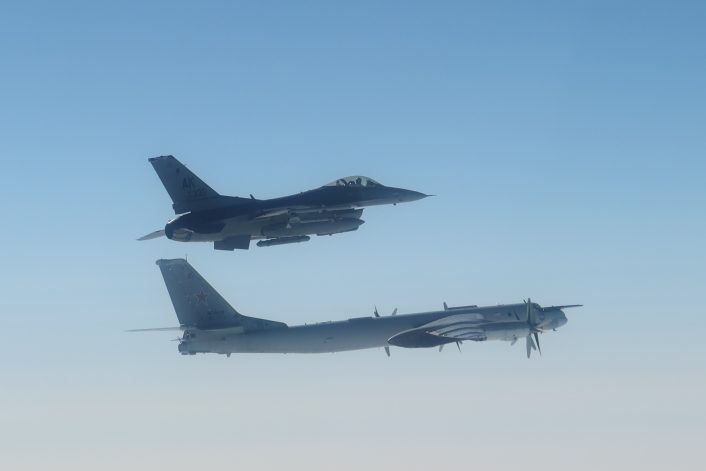Six Russian military aircraft, including Tu-95s, Tu-142 and A-50, were tracked operating in the Alaskan ADIZ and were intercepted by F-35s and F-16s.
NORAD released photos on the intercept of six Russian aircraft which were operating over the Bering Sea in the Alaskan Air Defense Identification Zone (ADIZ) on Apr. 14, 2025. According to NORAD, the Russian operated in the area for two and half hours and were positively identified, tracked, and intercepted by U.S. Air Force aircraft, which photos showed to be F-35s and F-16s.
The Russian aircraft were part of a larger package with multiple types, which included two TU-95 Bear H strategic bombers, one TU-142 F/J maritime patrol aircraft and anti-submarine plane, one A-50 Mainstay early warning plane, and two Su-35 Flanker fighters. Stars and Stripes reported that “the incursion took place in the Bering Sea, which separates Siberia from Alaska, about 290 miles northeast of Shemya, a small island near the western tip of the Aleutian Island chain.”
On April 14, 2025, @NORADCommand fighter aircraft positively identified, tracked, and intercepted Russian military aircraft through the Alaskan Air Defense Identification Zone (ADIZ) in international airspace west of Alaska. pic.twitter.com/6xMSQq2W3r
— Alaskan NORAD Region and Alaskan Command (@ANRALCOM) April 22, 2025
“The Russian aircraft remained in international airspace and did not enter American or Canadian sovereign airspace,” said NORAD. “This Russian activity in Alaskan ADIZ occurs regularly and is not seen as a threat.”
Contrary to many other occasions, “there were no indications of unsafe/unprofessional flying,” said NORAD’s spokeswoman Capt. Rebecca Garand of the Canadian Armed Forces. A recent video shot from the cockpit of a Su-35 shows the Russian aircraft flying very closely to an Alaskan F-35 during an intercept.

Recent close interactions
The recent video of the close encounter was undated, however the only other recent intercept which involved both F-35s and Su-35s in the Alaskan ADIZ was on Feb. 18, 2025. After the video emerged online, a NORAD spokesperson provided The War Zone with the following statement: “While we cannot verify the authenticity of the video, NORAD acknowledges an intercept of Russian aircraft on Feb. 18, 2025. The flight maneuvers of the Russian aircraft shown in the video are once again not what one would expect to see from a professional Air Force.”
#ColdWar2 The Russian fighter pilot has balls of steel. Well done! https://t.co/aYYA03GfmA pic.twitter.com/gj8mK3baZZ
— Capt(N) (@Capt_Navy) April 4, 2025
The six-second video first emerged on the Fighterbomber Telegram channel, which is well known for its ties to the Russian Aerospace Forces. The video appears to have been recorded with a cellphone, which panned from one side of the cockpit to the other and showed the F-35 on the right, the Su-35’s cockpit and a Tu-95 on the left.
— #WeHaveTheWatch —
On Feb. 18 & 19, 2025, @NORADCommand F-35 Lightning II fighter aircraft positively identified and intercepted 2 Russian Tu-95 and 2 Su-35 military aircraft in the Alaska Air Defense Identification Zone (ADIZ) remaining in international airspace west of AK. pic.twitter.com/yamTxXz7fY
— Alaskan NORAD Region and Alaskan Command (@ANRALCOM) February 21, 2025
While the Su-35 in the video appeared to be in a “stable” position near the F-35’s tail, keeping a rather short distance from it, on Sep. 23, 2024, during a routine intercept, a Russian Su-35 performed a dangerous maneuver, which was filmed from the cockpit of a U.S. F-16C fighter scrambled to intercept and escort the Russian aircraft.
The video captured the moment the Russian Su-35 fighter jet executed a turn toward the F-16. The Su-35’s sleek silhouette became increasingly visible as it banked abruptly into the F-16, revealing its maneuver to the camera.
“On Monday (Sept. 23), NORAD aircraft flew a safe and disciplined intercept of Russian military aircraft in the Alaskan ADIZ,” said Gen. Gregory Guillot, Commander, NORAD and U.S. Northern Command. “The conduct of one Russian Su-35 was unsafe, unprofessional, and endangered all – not what you’d see in a professional air force.”
This is not the first incident, and likely won’t be the last, where a Russian intercept has been labeled as “unprofessional” and “unsafe.” Over the years, there have been multiple reports of similar encounters, often involving U.S. Air Force MQ-9 Reaper drones, U.S. Navy P-8A Maritime Patrol and Reconnaissance Aircraft in regions like the Black Sea or off the coast of Syria.
Air Defense Identification Zone
An ADIZ is a designated area of international airspace, extending beyond sovereign airspace, where the identification of all aircraft is required for national security purposes and as explained in other articles here at The Aviationist, there’s a significant difference between territorial airspace and ADIZ.
The territorial sky is the airspace extending 12 nautical miles (about 22 km) from a country’s coastline and, just like in territorial waters, foreign aircraft can’t enter without permission, as it is considered sovereign territory.
The Air Defense Identification Zone (ADIZ) is a designated airspace surrounding a nation or part of it where strict identification, tracking, and control of aircraft are enforced for national security reasons. Aircraft flying within these zones without proper authorization may be intercepted by fighter aircraft on Quick Reaction Alert (QRA). ADIZ boundaries often extend beyond national airspace covering territorial waters, and while not defined by international law, any civil aircraft entering these zones is closely monitored and required to provide flight details for identification. Military aircraft not intending to enter national airspace are generally exempt from ADIZ procedures, but foreign military planes within ADIZ may be intercepted, identified, and escorted.









